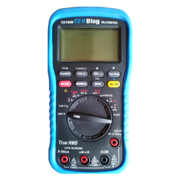Difference between revisions of "EEVBlog 121GW"
(start the 121GW device page) |
Uwe Hermann (talk | contribs) (Square, transparent background mugshot.) |
||
| Line 1: | Line 1: | ||
{{Infobox multimeter | {{Infobox multimeter | ||
| image = [[File: | | image = [[File:Eevblog 121gw mugshot.png|180px]] | ||
| name = EEVBlog 121GW | | name = EEVBlog 121GW | ||
| status = planned | | status = planned | ||
Revision as of 08:38, 30 September 2018
 | |
| Status | planned |
|---|---|
| Counts | 50000 |
| IEC 61010-1 | CAT III (600V) |
| Connectivity | Bluetooth LE, SD card |
| Measurements | voltage, current, power, resistance, capacitance, diode, continuity, frequency, duty cycle, period, temperature |
| Features | autorange, true-rms, auto hold, min/max, 1ms peak, 1kHz lowpass, relative, bargraph, backlight, 3V/15V diode, SD card logging |
| Website | eevblog.com/product/121gw/ |
The EEVBlog 121GW is a 50000 counts, CAT III (600V) handheld digital multimeter with SD card (firmware update, data logging) and BLE connectivity.
The EEVBlog host Dave Jones participated in the design of the device which gets manufactured by UEi. Some features are rare, or their combination has not been seen in other devices (15V diode test, builtin uCurrent to reduce burden voltage in current measurement, open schematics and hackable firmware).
Hardware
- HY3131 DMM
- AD8436 TRMS
- ADR3412 reference
- MAX4238 opamp (uCurrent)
- STM32L152ZDT6 MCU
- BLE122 BT module
- NJU6350R RTC, CR1220 battery
- split terminals and opamp for plug detection
- several 4052/4053 muxes
Photos
Protocol
SD
SD card logging generates CSV style files, with several header lines (non-comments) describing the test setup and start of recording, followed by data lines, and a final (non-comment) line when recording stops.
BLE
Several firmware versions implemented different protocol versions, as lessons were learned during development of the BT communication and apps for mobile devices. Recent versions use packets of 19 bytes each with binary data, to reduce the probability of data loss in the communication, and to slightly increase throughput since BLE is considered "low speed". The "Revised-Packet-Format-Blob-V2" PDF outlines the frame layout.
BLE communication is reported to be slow (some two samples per second), and occassionally flaky (truncated packets, reduced rate including gaps of non-activity, increasing error counts after longer periods of logging). The firmware and the protocol provide basic functionality, but may see some more development before becoming full featured and stable, or before more performance increases are seen.
BLE communication gets enabled by holding the 1ms PEAK button until the BT indicator changes. The meter needs a write trigger before it starts sending subsequent samples by means of notifications (BLE has no common or standard concept of serial communication, like BT does). This trigger is not needed for each sample (like some serial DMMs do), but it'd be required to re-establish communication after connection was lost (gsi, my assumption, not sure whether the write suffices or re-connect and write is due).
Each 19-byte packet communicates data for three displays ("main", "sub", and "bar", i.e. the two displays and the bargraph) as well as some "icon" state (indicators).
At the time of this writing sigrok does not support BLE communication. Possible workarounds would involve disguising the BLE communication as a COM port (users are reported to run gateways on ESP or nRF hardware), or to "replay" recordings of previously observed communication.
Quick experiment, manual inspection of BLE communication
$ hcitool lescan
$ gatttool -b DEV_ADDR --char-write-req -a 9 -n 0300 --listen
Resources
- Vendor's product page with firmware and manual download links, issue report form
- mobile app repo maintained by Dave2
- dozens of forum threads with hundreds of pages on the EEVBlog site
- lygte-info.dk Review and Teardown



